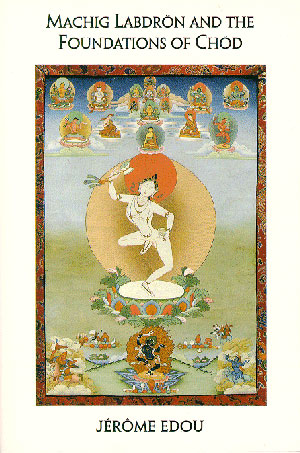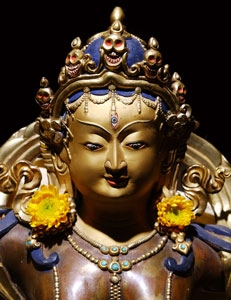
Machig Labdron & the Foundations of Chod
by Jerome Edou
Publisher: Snow Lion Publications; 1st. Ed edition (October 25, 1995)
Language: English
ISBN-10: 1559390395
ISBN-13: 978-1559390392
Synopsis:
This translation of the most famous biography of Machig Labdron, the founder of the unique Mahamudra Chod tradition, is presented together with a comprehensive overview of Chod’s historical and doctrinal origins in Indian Buddhism, and its subsequent transmission to Tibet. Chod refers to cutting through the grasping at a self and the emotional afflictions. Most well known for its teaching on transforming your body and aggregates into an offering of food for demons as a compassionate act of self sacrifice, Chod aims to free the mind from fear and to arouse realization of its true nature, primordially clear bliss and emptiness. Historically, Machig Lapdron was a Tibetan woman who was a contemporary of Milarepa and she founded the Chod lineage, but she is also popularly considered to be both a dakini and an emanation of Prajnaparamita.
“Provides some wonderful material on the Chod lineage, Machig Lapdron`s biography, and the origins of Mahamudra Chod. With its publication, we come a little bit closer to feeling the spirit and incisive wisdom of this great yogini.” Tsultrim Allione.
Extract : Preface
The mysterious home of the dãkini.
—Mahasiddha Tilopa
It began at a farmhouse in the lower Alps where I was staying with a Tibetan lama recently arrived from India. That evening I heard resounding from his room the slow rhythm of a haunting melody which he intoned in his rich bass voice, accompanying himself with drum and bell, occasionally blowing the thighbone horn. Throughout the night I was held spellbound by this moving song, so different from any other ritual chant I had ever heard before. I suddenly found myself immersed in the strange and bewildering universe of Chöd, an ageless world of such antiquity as to have survived only in some forgotten isolated pockets of the Tibetan highlands.
Ever since that evening more than fifteen years ago, I haven’t been able to let go of Machig Labdrön, the eleventh-century Tibetan lady who was the primary source of inspiration for the Chöd tradition. I looked for her in the Himalayan foothills and in the monasteries of Ladakh and Dolpo. I traced her footprint at Tiger’s Den (Taktsang) in Bhutan and sensed her presence at her former retreat place of Copper Mountain (Zangri), among the nuns of Shuksep, as well as at Dampa Sangye’s hermitage at the foot of Mt. Everest. I read echoes of her passing and of her lasting influence in texts, on walls and along pilgrimage routes. On the banks of Lake Namtso, for instance, during the coldest month of the Tibetan winter, I found a group of nomads practicing the Chöd of Machig in a cave of Tashido, the Rock of Good Fortune.
Several lamas in the authentic transmission lineage of Chöd have advised me throughout this lengthy project, enabling me today to present this translation of the most famous biography of Machig Labdrön (1055-1153) together with an outline of her tradition, the Chöd of Mahämudrã. This translation and most of the commentaries come from two main texts, the first of which is known as An Exposition of Transforming the Aggregates into an Offering of Food, Illuminating the Meaning of Chod (henceforth Transforming the Aggregates’), the first two chapters of which comprise The Marvelous Life, generally considered to be an autobiography of Machig. This short version of Machig’s life seems to come from a more extensive version which I have used as a reference, entitled The Concise Life Story of Machig Labdrön, Derived from An Exposition of Transforming the Aggregates into an Offering of Food (henceforth The Concise Life Story).
Finally, while travelling in Dolpo just a few months before printing this book, I found at Lang Gonpa near Phyger a third version of Machig’s hagiography called simply A Biography of Machig, an anonymous and unpublished manuscript,3 quite different from the other two versions, which I have used as a reference.
The need to take up this research before the disappearance of the last witnesses of the living tradition of Tibet has lent a sense of urgency to the enterprise. The corpus of texts by now assembled has become quite overwhelming and the subject in itself is vast, even taking into account the loss of numerous sources of information in the twentieth-century cyclone of cultural devastation unleashed over Tibet. Within the limits of this study certain choices seemed imperative. Some aspects were expanded, others eliminated altogether. At the core remain a number of extracts from the available Tibetan literature, presented in the light of authentic commentaries from the oral tradition.
Having had the opportunity to live and study in close proximity to Tibetan lamas, yogins and erudite scholars, I have been able to address them with my numerous questions. Some replied, others merely smiled. From the Venerable Tenga Rinpoché I received the transmission of the rite. From the Venerable Gendün Rinpoché and Kalu Rinpoché I obtained the initiation of Machig (the latter, during a private interview, showed me a relic of Machig’s son which he constantly carried on him in his personal gau). I received the explanations and commentaries on the practice, as well as the meditation transmission, from the Venerable Khenpo Tsultrim Gyamtso, accomplished yogin and incomparable scholar, who encouraged me to undertake the present work, and its completion is definitely thanks to his inspiration. In spite of remaining errors and imperfections for which I am solely responsible, I sincerely hope that
Just like the dawn sun rising in the night sky,
This authentic teaching aimed at cutting through demons
Might cause the light to burst forth in all directions of space.
PHAT!

New extract
At the age of fourty-one, Machig Labdron stayed in a retreat cave in Chipug which was blessed for practice. On the fourth day of the last month of spring, in the middle of the night, the majestic Lady Tara appeared, surrounded by numerous dakinis. She bestowed on Machig the four initiations of the five primordial Buddhas according to the Udumvara Tantra…
Thereupon Machig composed a hymn of praise to each of the five Buddha families and later improvised another one in twenty-one stanzas to Tara herself. She then addressed Tara as follows: “You have shown me great kindness and given me the most extraordinary power of initiation and blessing. Yet I don’t know if a woman like me, not particularly bright, and of feeble capacities, will be able to accomplish the benefit of beings…”
Tara smiled, then after a quick glance at the dakinis of her entourage, she said: “Yogini, do not feel discouraged! In the course of previous lives you have studied and mastered the meaning of the scriptures of Sutra and Tantra. So today it is sufficient for me to reveal this meaning to you through mere symbols. You are a mind emanation of the Great Mother Yum Chenmo: we are inseparable. You are the wisdom dakini, the sovereign of the Vajradhatu and the source of the liberation of all phenomena. Don’t lose heart. Keep your determination.”
But Machig replied: “How could I possibly be an emanation of the Great Mother, inseparable from you? And in what way am I the source of the liberation of all phenomena? And where is the residence of the Great Mother?”
Tara answered, “Yogini, although in your innermost heart there is clear knowledge about the past, listen carefully and I’ll explain it to you. The one known as the primordial Mother Yum Chenmo is the ultimate nature of all phenomena, emptiness, the essence of reality, free from the two veils. She is the pure expanse of emptiness, the knowledge of the non-self. She is the matrix which gives birth to all the Buddhas of the three times.
“However, so as to enable all sentient beings to accumulate merit, the Great Mother appears as an object of veneration through my aspirations and prayers for the sake of all beings. And so, through the power of my wishes and compassion, from the dharmata there appears bright light in the shape of an orange-colored bindu marked with the syllable MUM, ablaze with light. In turn this transforms into the Great Mother Yum Chenmo, golden in color, with one face and four hands, sitting in the vajra posture, her body beautiful with all the major and minor marks of a Buddha. Surrounded by her princely sons, the Buddhas and bodhisattvas of the ten directions, Yum Chenmo resides in the Gandavyuha sphere of the celestial pure land of Akanistha, in a marvelous celestial palace.
“From my heart there radiates a greenish-black ray of light marked with the syllable HUNG and it enters into the Mother’s heart, awaking her. Then it radiates out again gathering the power of the Buddhas and bodhisattvas of the ten directions and it dissolves agiain into the Mother’s heart. Instantly, she transforms into a sky-blue dakini with one face and four hands. She is the sovereign of Vajhradhatu. From her body, speech, mind, qualities and activity appear innumerable manifestations. Among these, the mind emanation is the bluish-black Vajra Lady with one face and two hands who subjugates all demons. On the crown of her head is a boar’s head emerging from her hair. Her splendor illuminating the three worlds, she gathers all the dakinis under her power. She sets all demonic forces to work as her servants; she is the source of the liberation of all phenomena.
“Now this Vajra Lady, who subjugates all demons for the sake of all sentient beings, took numberous births in appropriate times and places. She mastered the Pitakas and accomplished tremendous deeds for the sake of living beings. Finally she took birth in Tibet. She is no other than yourself, Shining Light of Lab.”




